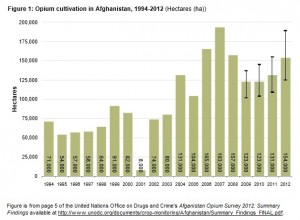 Crowdsourcing! Big Data! International Development! A recent Washington Post article on future U.S. Agency for International Development (USAID) monitoring and evaluation (M&E) activities in Afghanistan piqued many of my interests.
Crowdsourcing! Big Data! International Development! A recent Washington Post article on future U.S. Agency for International Development (USAID) monitoring and evaluation (M&E) activities in Afghanistan piqued many of my interests.
According to the article, after coalition forces withdraw from Afghanistan next year, only 20 percent of U.S.-funded reconstruction projects worth billions of dollars will be in areas safe enough for U.S. officials to visit and directly inspect. For this reason, USAID “intends to use satellite photos and ‘crowdsourcing’ experiments that will solicit feedback on progress from Afghans who are supposed to benefit from U.S.-financed work.” These experiments are to supplement the work of Afghans with engineering and program-monitoring skills, who will be tapped for the majority of onsite M&E activities.
My first thought was “Wow! Fascinating!” My second thought was why limit the satellite photos and “crowdsourcing” experiments to Afghans? It’s easy to imagine scenarios, for example, combining the best of the South Sudan Satellite Sentinel Project, USAID’s crowdsourcing initiative to geocode and standardize its Development Credit Authority (DCA) loan guarantee data, and the U.S. Civil Air Patrol’s crowdsourced aerial imagery assessment following Super Storm Sandy. Crowds worldwide could easily view online photos of, for example, USAID-supported construction or agriculture/irrigation projects. In the latter example, digital volunteers could view a photo and select (a) for pink/red poppy flowers, (b) for violet/light purple saffron flowers, (c) for light green or tan wheat, or (d) for other.
Due to the high levels of corruption in Afghanistan and the critical levels of insecurity, such an approach would likely be more accurate and safer than sending in potentially bribable and frightened Afghans with GPS- and timestamp-enabled digital cameras and smart phones to monitor and evaluate corruption-prone USAID-supported projects. Such an approach also could possibly improve accountability (or at least keep it from plummeting after coalition forces withdraw) and help make a dent in the recent rise in opium production in Afghanistan (yes, despite USAID assistance and the U.S. military presence). Online transparency often breeds self-correcting behavior since government officials, businesses, and individuals (including USAID-funded monitors) do not want to be publicly caught doing (or be associated with) something embarrassing or illegal.
After reading the draft USAID Remote Monitoring Project Indefinite Quantity Contracts (IQCs) Request for Proposals, however, I could see involving non-Afghans in crowdsourcing M&E is not currently envisioned or was at least not mentioned in the draft (the final solicitation has yet to be released). Any global crowdsourcing scenario would have to fly with the Government of Afghanistan, who might perceive online satellite and aerial imagery provided by the U.S. National Geospatial Intelligence Agency differently than something like the South Sudan Satellite Sentinel Project and its Harvard University-provided satellite and aerial imagery.
The draft solicitation did offer other interesting tidbits:
- Information about construction projects, training event attendance, etc. would be relayed using GPS-enabled and time-stamped smartphone applications and cameras, similar to what International Relief and Development is doing to remotely to monitor the World Bank’s multibillion-dollar Afghanistan Reconstruction Trust Fund.
- SMS cell phone and interactive voice response surveys would be used to gather information about health and education efforts, similar to the USAID-funded mPowering Frontline Health Workers project. They would also be used to obtain information on municipal service delivery.
- A knowledge management strategy would be used to centralize the data collected under the various monitoring tasks. It is unclear whether data analytics could or would be used on this knowledge management strategy similar to what the U.S. Department of Health and Human Resources Office of Inspector General does to monitor prescription drug fraud under Medicare Part D.
I look forward to learning more about this M&E project as it develops. With billions of dollars at stake, the incentive is great for interesting and creative crowdsourcing, big data, and international development M&E innovations to take shape.

Crowdsourcing is fascinating and creating an incentive program to have people want to provide input is the key. But the major drawback is how to obtain reliable data and not false data…how do you QC the data??
Thanks for visiting my blog, Fred, and leaving a comment. I agree in principle that an incentive program would be key. But with the amount of corruption and insecurity in Afghanistan, I would worry about how it was structured. You could easily see payment combined with pressure from a local warlord leading to skewed data or “recognition” incentives leading to serious security problems for evaluators, etc. In the identifying photos of poppy example I gave, I could see some sort of incentive possibly (involving crowdsourcing among the international community online). However, digital volunteers often just volunteer a few hours here and there with exceptional results. For example, my understanding is crisis mappers are among the best organized aid workers producing the highest quality work in the Ebola response arena and most of them are working for free/are volunteers. It will be interesting to see how or if this project finds a way to incentivize without adding to the country’s corruption problem, thereby undermining democratization and longer-term stability. I have not heard anything about this project being awarded (have you????), although the recent news about Louis Berger and International Relief and Development makes it obvious competent monitoring and evaluation is critical there.
🙁